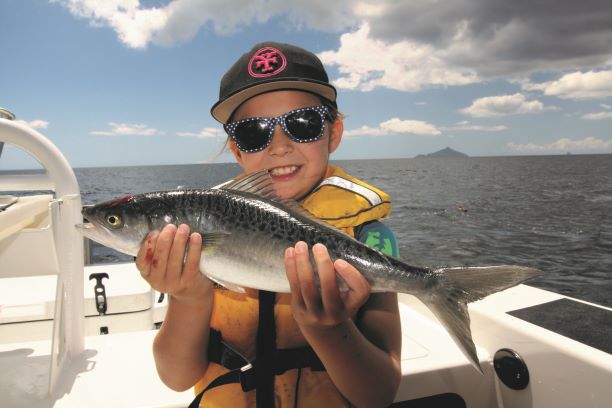Kahawai is described as ‘the people’s fish’, such is its ready availability and wide geographic spread around our coastline. Whether you be fishing at the top of the north, or the bottom of the south, kahawai are likely to be encountered.
They are a great fighting fish, especially when targeted on light tackle, and pound
for pound, few other species could best them as an angling adversary.
Kahawai are particularly susceptible to a lure, whether it be a soft-bait, a small feather trolled behind a boat, a fly or a spinner retrieved on casting gear.
They can also be the most frustrating of fish to catch, especially when the angler cannot ‘match the hatch’ – produce a lure similar to what the fish are feeding on.
At times they can be finnicky eaters only taking something that closely resembles their current diet, whereas at other times
a bit of white rag attached to a hook will
do the job.
Kids love kahawai. I cut my angling ‘teeth’ fishing for kahawai in the Kawhia Harbour when they would be chasing the whitebait runs in spring.
Dad’s favourite lure was to cut the clear bottom half off a Bic ballpoint pen and threat a line with a hook through it – cheap and deadly!
Trolling is an effective way to catch kahawai. It works best when schooling fish are feeding on the surface, but you can also catch kahawai when they’re not visible by towing small lures through the white water close to islands and headlands and near river mouths.
A variety of lure types are suitable for trolling, but avoid any that twist the line. A good quality swivel can make all the difference, but the metal jigs, spinners and slices that are great for casting and retrieving are often not good choices for trolling, because they impart too much
line twist.
Small to medium-sized Smith’s plastic trolling lures are proven fish-takers, as are small chrome or plastic spoons and small to medium-sized Rapala-style bibbed lures. Bib-less trolling/crank baits also work, along with small plastic or Mylar-skirted lures and saltwater flies.
Natural colours are best and size is important, so don’t go too big, and make sure the hooks are strong enough. If not, replace them with in-line singles or stronger saltwater trebles.
Running lures slightly under the water’s surface can be a good way to improve trolling success. For this there are several commercially available devices such as paravanes and planning boards to get the lures down a little.
Tips for Catching Kahawai
» Troll speed should be around 3-5 knots, and vary it regularly
» If fish not schooling on the surface, try running your lures around rocky headlands
» Keep an eye out for terns, their presence in any number will indicate fish below
» Run your lures 20-30 metres behind the boat
» When you get a strike, keep motoring ahead in the hope of hooking others
» Don’t troll through a work-up, skirt around it
» If you are fishing for the table, iki your fish, bleed it and put it in an ice slurry immediately
» Troll in direction fish are heading, not towards them.
Author: Grant Dixon NZ Fishing News

